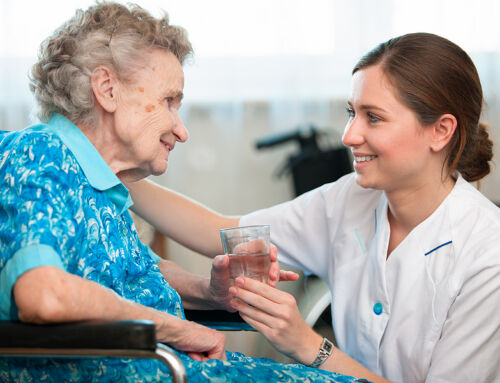In the United States, more and more people are taking on the role of caregiver to an aging loved one. In fact, a 2015 study by The National Alliance for Caregiving revealed that over 34 million adults are serving as a caregiver for a senior. Most caregivers are female (60 percent), and they are 49 years old, on average. A huge majority of caregivers (85 percent) provide care for a relative with nearly half are caring for a parent or parent-in-law.
Caregiving can entail a wide variety of tasks—assisting with instrumental activities of daily living (IADLs) like providing transportation, grocery shopping, paying bills, or housekeeping, and/or helping with activities of daily living (ADLs) like bathing and using the toilet.
It’s a lot to take on, even on a part-time basis, especially for caregivers who may also have a career and their own children. This labor of love can result in lost wages, pension, and Social Security benefits for the caregiver—some estimates put that number at nearly $3 trillion annually in lost income for Americans.
But what do caregivers do when they live far away from their aging loved one? Long-distance caregiving, defined as living more than an hour from the care recipient, can present its own set of challenges.
>> Related: Sibling Rivalry: When Family Members Disagree on Senior Care Options
Long-distance caregiving by the numbers
According to the National Alliance for Caregiving, around 15 percent of family caregivers live more than an hour away from their care recipient. This represents approximately 5 million caregivers, a number that is expected to grow in the coming years. Some more facts and figures on long-distance caregivers:
- Most caregivers spend some of their own money on care-related expenses for their loved one, but AARP figures from 2016 found that long-distance caregivers have the highest annual expenses, averaging around $12,000 each year. In addition to travel costs, those living far from their loved one often have to use paid help (41 percent). It’s not surprising that these hefty costs cause financial strain for more than 20 percent of long-distance caregivers.
- The National Alliance for Caregiving and AARP have found in their research that long-distance caregivers are more likely to report emotional distress (47 percent) as compared to caregivers who are either living with their care recipient (43 percent) or who live less than one hour away (28 percent).
>> Related: Aging in Place: Hidden Costs of Using Family as Caregivers
A challenging reality
If you are acting as a long-distance caregiver, you know how difficult it can be to get an accurate handle from afar on how your loved one is faring. Technology like Skype and FaceTime may have improved the situation a bit, but it’s still no substitute for assessing and managing a situation in person. And when you are there to see for yourself, the realities of your loved one’s circumstances can often be guilt- and anxiety-producing.
Of course, a simple solution would be to either move closer to the aging loved one or have them move closer to you, but that often isn’t a viable choice. So, if long-distance caregiving is the only or most practical option, what can you do to make the best of a sometimes-challenging situation?
Focus on what you can do
The tendency of many long-distance caregivers is to focus on all the things they are unable to assist with from afar (hence the guilt). Instead, concentrate on the many things you can do remotely. In the internet age, this is becoming increasingly easy. For example:
- Research and find a reputable housekeeper, and schedule weekly or twice-monthly visits to your loved one’s home.
- Call your loved one’s physician to get an unbiased assessment of any health issues and to advocate for the senior if necessary. Your loved one will need to authorize the doctor to release their private health information to you, but it is typically a simple HIPAA release form that will need to be filled out.
- Set up online banking for your loved one’s accounts so that you can manage their bill payments remotely.
- Set up a food or meal delivery service. In today’s hectic world, there are more and more options available for healthy food or meals to be brought to your doorstep. Also, Meals on Wheels is a wonderful organization that helps disadvantaged seniors with nutrition as well as social isolation.
- If a sibling or other family member lives closer and is acting as a primary caregiver, schedule a longer visit, and offer to give that person an extended break. (This is sometimes referred to as respite care.)
>> Related: Caregiver Assistance: Addressing Caregiver Stress
Other long-distance caregiving tips
Communicate often
Yes, visit in person as often as you can, but in the interim, be sure to reach out to your loved one on a regular schedule—perhaps every day or weekly, depending on their situation. Again, if possible, take advantage of video technology like FaceTime so that you can actually see the person. That can be helpful to not only allay your concerns but also to uplift your loved one.
Make an emergency plan
Having a robust emergency plan in place can alleviate some of the anxiety around the “what ifs” of long-distance caregiving. Make a list of important contact names and numbers including other family members, nearby friends and neighbors, and physicians. Get copies of important legal and medical documents like insurance policies, advance directives, and a will, and be sure to have a list of the care recipient’s current medications. Be sure you’ve also set up a healthcare power of attorney and durable power of attorney.
>> Related: Do You Need to Update Your Estate Planning Documents?
Use your resources
If there is something that you are struggling to do from afar or on your limited visits with your loved one, let the professionals help. Whether it’s contracting with someone (or enlisting a helpful neighbor) to maintain the yard, coordinating a transportation service to take your loved one shopping or to the doctor, or hiring an in-home care specialist to assist with ADLs, there are people who are ready to help.
A geriatric care manager is another option to consider too, acting as a “professional relative” for those who need care, though their services can be pricey (from $50+ an hour). They can help with everything from doing in-person visits with your loved one to hiring and coordinating in-home care.
In addition to video chat apps like Skype, there are numerous other technology-based resources that are useful for long-distance caregivers too. Web-enabled home sensor systems, smartphone medication reminders, and more can be used from afar to help an aging loved one.
Take care of yourself too
Many caregivers put themselves last and suffer their own negative health consequences as a result of their caregiving duties. While this is especially true for primary caregivers, it also can apply to remote caregivers who may be susceptible to increased levels of stress and anxiety, both of which are detrimental to your overall health. If you are feeling overwhelmed by your situation, talk with your doctor or a mental health professional about stress management techniques.
>> Related: Pre-Crisis vs. Post-Crisis Planning: Confronting Life’s Unknowns
Caring across the miles
It is increasingly common today for family members to live far away from one another. Whether that distance is for a job, an education, a relationship, or simply by choice, the miles can become challenging when an aging long-distance loved one needs care.
Acting as a long-distance caregiver isn’t easy, but by getting organized, utilizing available resources and technology, and focusing on the positive, you can still do a world of good for an aging loved one, even from far way.

FREE Detailed Profile Reports on CCRCs/Life Plan Communities
Search Communities






